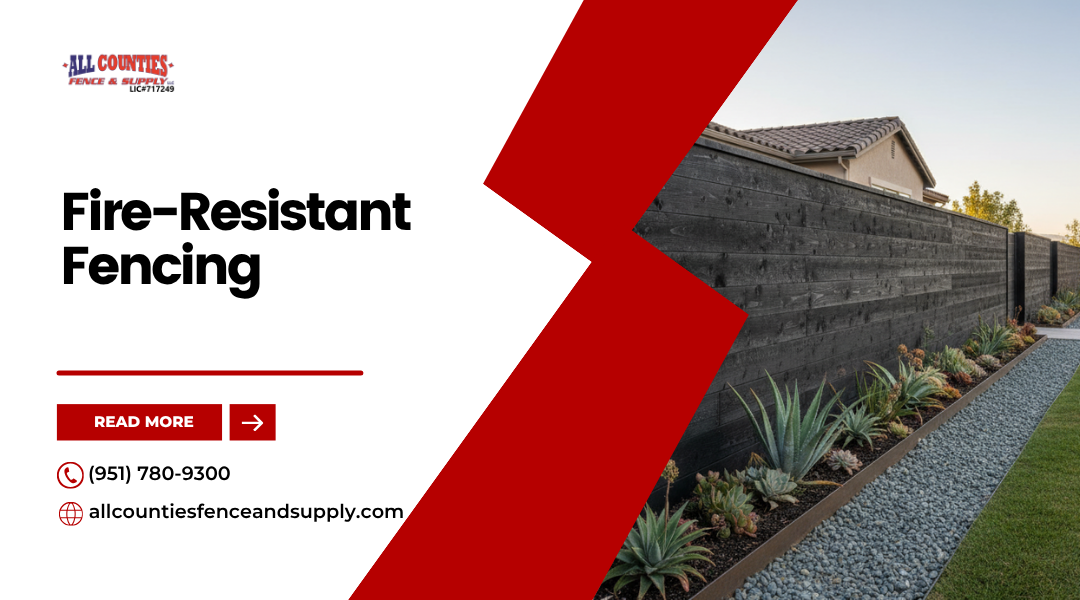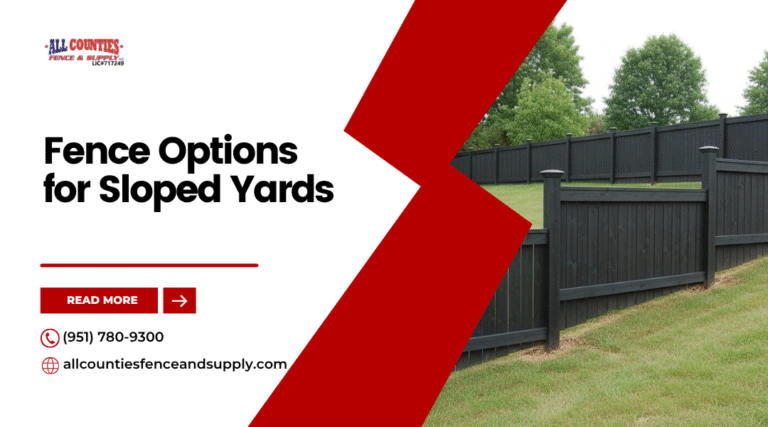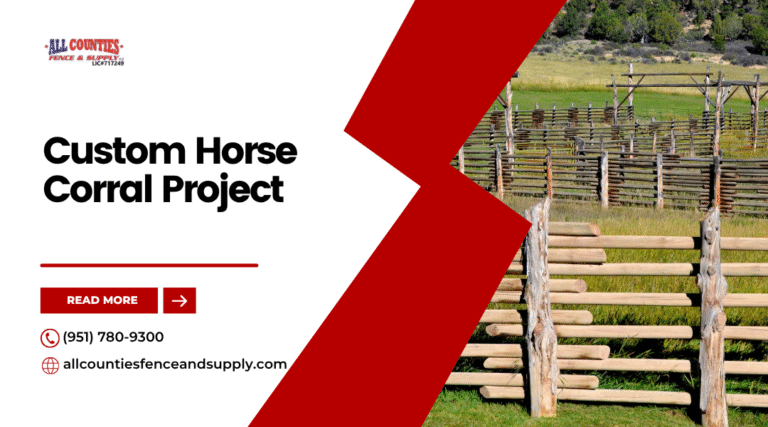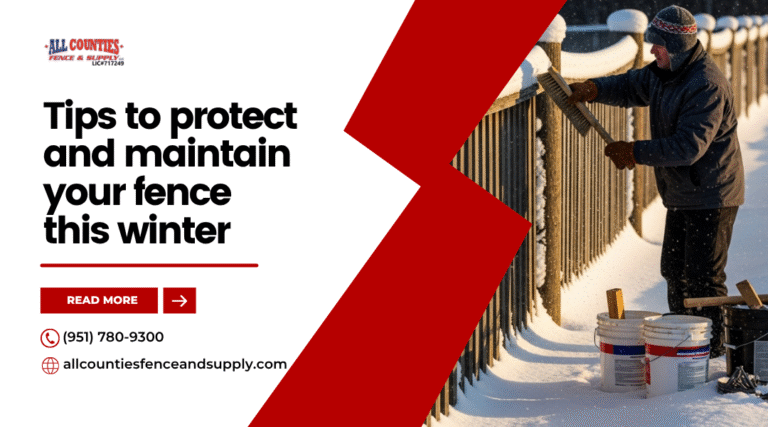Wildfires continue to reshape how you protect your property in California. Choosing the right fencing material isn’t only about style or privacy—it’s about safeguarding your home from embers, heat, and direct flame exposure. Fire-resistant fencing materials help create a critical barrier that slows fire spread and reduces the likelihood of ignition near your home.
You face unique challenges living in a region where defensible space and building codes evolve to meet rising wildfire risks. Understanding how different materials—like steel, aluminum, or other non-combustible options—perform under heat gives you the knowledge to make informed, code-compliant decisions. Each choice affects not just safety, but also your fence’s durability, maintenance, and long-term value.
By exploring how fire-resistant fencing works, comparing material options, and learning key installation practices, you can design a fence that protects your home without sacrificing appearance or function. The right approach helps you meet California’s wildfire safety standards while maintaining peace of mind year after year.
Understanding The Importance Of Fire-Resistant Fencing In California
Fire-resistant fencing helps you reduce ignition risks around your property, comply with evolving safety codes, and strengthen your home’s first line of defense in wildfire-prone regions. Using non-combustible materials and proper placement can slow fire spread and improve your property’s overall fire protection.
California’s Wildfire Climate And Risk Zones
California experiences long, dry seasons, high winds, and dense vegetation that make many areas extremely fire-prone. These conditions create what the state classifies as Fire Hazard Severity Zones, which include Very High, High, and Moderate risk categories.
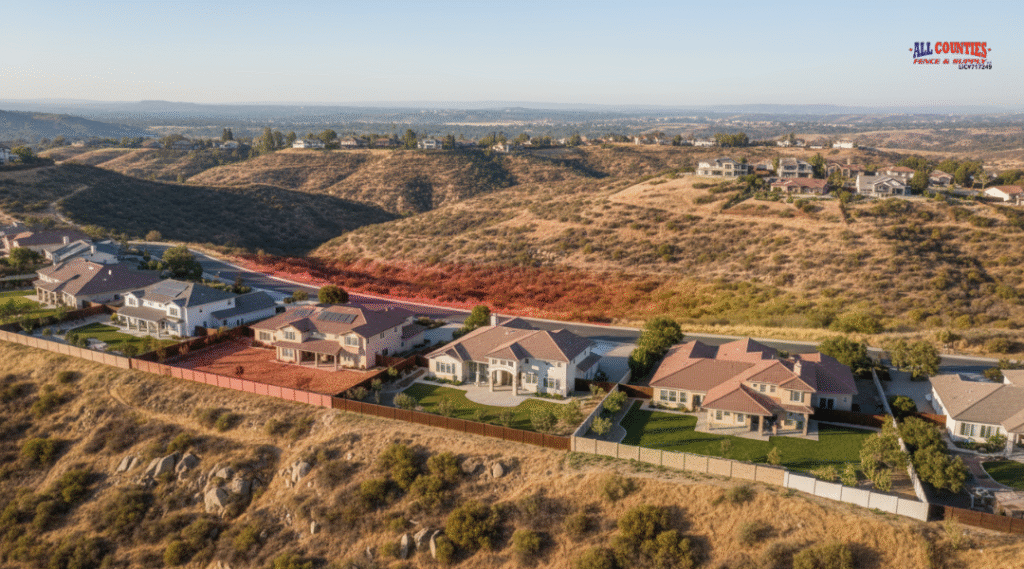
You can find your property’s classification through Cal Fire’s Fire Hazard Severity Zone maps. Homes located in Zone 0, the first five feet around structures, face the highest ignition threat from embers and radiant heat.
Properties in these zones require non-combustible materials and strict maintenance to comply with defensible space standards. Choosing fire-resistant fencing materials such as steel, aluminum, or wrought iron helps you meet these standards and reduce your home’s vulnerability to fast-moving wildfires.
How Fences Can Contribute To Fire Spread Or Protection
Combustible fences, especially wood or vinyl, can act as fuel during wildfires. When flames or embers reach these materials, they can ignite quickly and carry fire directly to your home or neighboring structures.
Non-combustible fences serve the opposite purpose. Materials like galvanized steel, corrugated metal, or powder-coated aluminum resist ignition and block radiant heat. They create a physical barrier that slows or stops the spread of fire across property lines.
Proper installation also matters. Keeping fences clear of dry vegetation and ensuring metal panels are securely anchored improves both durability and fire safety. In high fire risk areas, these details can determine whether a fence becomes a hazard or a protective feature.
State And Local Building Requirements For Fire Safety
California’s building codes now restrict combustible fencing materials within five feet of homes in designated wildfire hazard zones. The California Building Code (CBC) and Public Resources Code outline these requirements to reduce structure-to-structure ignition.
You must use non-combustible, fire-resistant, or fire-retardant-treated materials in these buffer areas. Local jurisdictions may have additional ordinances based on community risk assessments.
Some areas, including Firewise Communities and Wildfire Severity Zones, encourage or require compliance with Zone 0 standards. Installing fencing that meets these codes not only enhances fire protection but also supports insurance eligibility and community safety efforts.
Key Qualities Of Fire-Resistant Fencing Materials
Effective fire-resistant fencing depends on measurable fire ratings, the ability to withstand heat and embers, and consistent upkeep. These qualities determine how well your fence performs under wildfire conditions and how long it remains protective.
Fire-Resistance Ratings And What They Mean
Fire-resistance ratings indicate how long a material can resist ignition and structural failure when exposed to fire. You often see these expressed in minutes, such as a 30-minute flame immersion test, which measures whether a fence material maintains integrity after direct flame contact for half an hour.
Common rating categories include:
| Rating | Description | Typical Materials |
|---|---|---|
| Class A | Highest resistance; withstands severe exposure | Steel, concrete, masonry |
| Class B | Moderate resistance | Fire-retardant wood, composite |
| Class C | Basic resistance | Certain treated vinyl or low-density composites |
When choosing materials, look for tested and certified ratings from recognized standards such as ASTM E84 or UL 94. These tests provide a consistent way to compare materials like steel, aluminum, and fire-retardant treated wood.
Material Durability Under Heat And Ember Exposure
Durability under heat and ember attack determines how long your fence can protect your property during a wildfire. Non-combustible materials, such as steel, aluminum, and concrete, resist ignition and maintain structure even when exposed to radiant heat or flying embers.
Metal fences may deform at extremely high temperatures but rarely ignite. Concrete and masonry remain stable and provide excellent thermal mass, slowing heat transfer. In contrast, fire-retardant treated wood resists ignition longer than untreated wood but can degrade after repeated exposure or if the treatment weathers away.
To reduce ember penetration, install fencing with minimal gaps and use metal mesh or solid panels near structures. This limits ember intrusion, which is a leading cause of fence-related fire spread in California’s Zone 0 areas.
Maintenance And Longevity Considerations
Maintenance directly affects the long-term fire resistance of any fence. Even non-combustible materials require care to prevent corrosion, cracking, or buildup of flammable debris. Regular cleaning removes leaves and dry vegetation that could ignite during ember storms.
For metal fences, inspect coatings or galvanization to prevent rust that weakens structural performance. Repainting or recoating every few years helps maintain integrity.
If you use fire-retardant treated wood, reapply sealants as recommended by the manufacturer since UV exposure and moisture can reduce fire resistance.
Concrete or masonry fences need minimal upkeep but should be checked for surface damage or gaps where embers might lodge. Consistent maintenance ensures your fireproof fencing remains effective and extends its service life in wildfire-prone environments.
Comparing The Most Common Fire-Resistant Fencing Materials
Selecting a fire-resistant fence means weighing durability, cost, and maintenance against fire performance. Materials like metal, concrete, composite, and treated wood each resist ignition differently and serve distinct design and functional needs for California’s wildfire-prone environments.
Metal Fences (Iron, Steel, Aluminum) — High Protection And Modern Appeal
Metal fences, including iron, steel, and aluminum, provide some of the highest levels of fire resistance available. These materials are non-combustible, meaning they will not ignite or contribute to flame spread. Steel fencing and aluminum panels are especially effective in Zone 0 areas near buildings, where non-combustible construction is required.
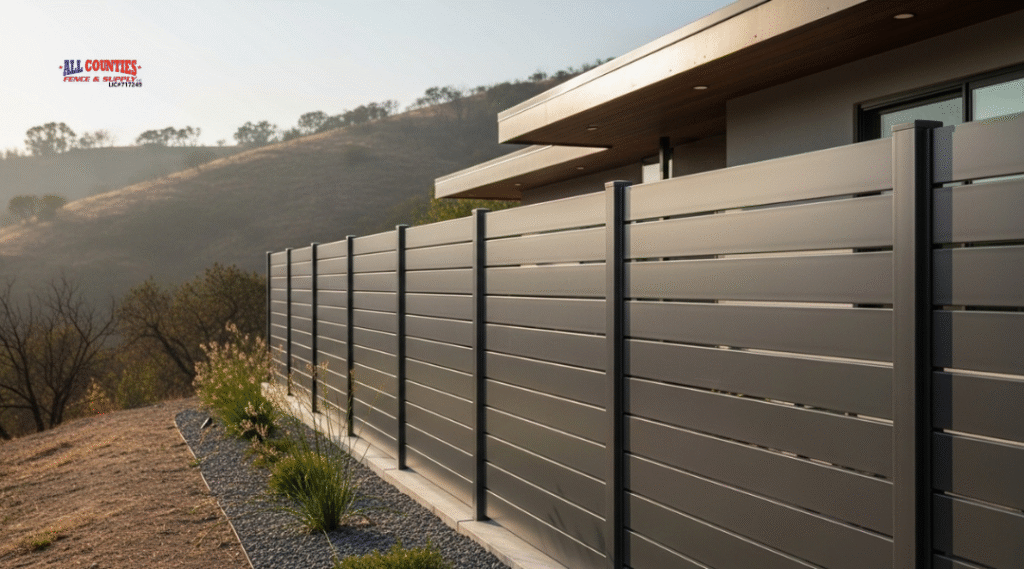
You can choose from solid panels, perforated sheets, or woven wire fences depending on your design and airflow needs. Steel offers superior strength and longevity, while aluminum resists corrosion and requires less maintenance in coastal or humid regions.
Although metal fences withstand high temperatures, they can warp or discolor under extreme heat. Regular inspections for rust and repainting with heat-resistant coatings help preserve appearance and structural integrity. Despite higher upfront costs, metal remains one of the most reliable options for long-term wildfire defense.
Concrete Or Masonry Fences — Maximum Barrier And Low Maintenance
Concrete and masonry fences act as complete fire barriers because they are non-flammable and resist heat transfer. These fences can block radiant heat and embers, protecting nearby structures. Their solid mass also reduces wind-driven ember intrusion, a major cause of home ignition during wildfires.
You can build them with poured concrete, concrete blocks, or stone masonry. Each option offers exceptional durability and minimal upkeep. Unlike metal, concrete does not corrode or require coatings.
The main trade-offs are weight, cost, and installation time. Concrete fences often require reinforced footings and professional installation. However, once installed, they demand little maintenance beyond occasional cleaning and crack repair. For properties in high-risk zones, masonry provides one of the most effective and permanent fire-resistant solutions.
Composite Fences — Balanced Aesthetics With Fire-Resistant Core
Composite fences combine wood fibers and plastic resins, offering a look similar to wood with improved fire resistance. Many modern composite panels are rated for Class A fire performance, meaning they resist ignition longer than untreated wood.
You benefit from low maintenance since composites do not rot, warp, or need repainting. Some high-quality products include fire-retardant additives that enhance resistance to ember exposure.
However, not all composites perform equally. Lower-grade versions can melt or deform under high heat. When selecting composite fencing, verify its fire rating and ensure installation meets California’s Wildland-Urban Interface (WUI) standards. This material works best when combined with non-combustible posts or metal framing to increase structural safety.
Treated Wood Fences — Limited Protection When Properly Sealed Or Coated
Fire-retardant treated (FRT) wood offers moderate protection compared to metal or concrete. It retains the natural look of wood but undergoes chemical treatment to slow ignition and flame spread. This makes it a suitable compromise for homeowners who prefer a traditional appearance while improving safety.
You should reapply fire-resistant sealants or coatings periodically, as weather exposure can reduce effectiveness. Keeping vegetation and debris clear of the fence line also helps maintain performance.
Treated wood is still combustible, so it should not connect directly to structures or be used within the first five feet of a building in high-risk areas. When maintained properly, it provides limited but meaningful protection and remains one of the more affordable fire-resistant fencing options.
Design And Installation Tips For Fire-Safe Fencing
Proper fence design and installation help reduce wildfire risks by limiting ignition points, controlling ember exposure, and maintaining defensible space. Material choice, placement, and layout all influence how well your fence performs during a fire.
Safe Fence Placement: Distance From Structures And Vegetation
Keep at least five feet of non-combustible fencing or a metal gate section between your house and any combustible fence. This separation prevents a burning fence from transferring flames directly to your home’s siding.
Maintain Defensible Space Zones by clearing dry grass, pine needles, and mulch from the fence base. Avoid using wood chips or bark mulch near the fence line. Instead, use gravel or compacted soil to limit fuel buildup.
Inspect and clean the area regularly. Even small debris or leaf litter can allow flames to spread upward. When possible, design fences to allow airflow—such as with open metal slats—to prevent ember accumulation and reduce radiant heat exposure.
Integrating Fire Breaks And Non-Combustible Zones
A fire break separates combustible structures and vegetation, slowing fire spread. You can create these breaks using non-combustible materials like steel, aluminum, concrete, or stone.
Install a short section of metal fencing or a masonry wall between wood fences and buildings. This barrier acts as a non-combustible zone, reducing the chance of direct flame contact.
Where properties are close together, a steel perimeter fence can serve as a radiant barrier, protecting both sides from heat exposure. Keep at least 3–5 feet of clear space around the fence to allow maintenance access and prevent vegetation from encroaching into the fire break area.
Combining Materials For Functionality And Aesthetics
You can design a fire-safe fence that balances durability, privacy, and appearance by combining materials strategically. Use metal or fiber cement panels near structures and wood or composite sections farther away where ignition risk is lower.
A simple layout might include:
| Fence Section | Recommended Material | Purpose |
|---|---|---|
| 0–5 ft from home | Steel or aluminum | Non-combustible barrier |
| 5–30 ft zone | Fiber cement or treated wood | Moderate fire resistance |
| Beyond 30 ft | Decorative wood or vinyl | Lower exposure area |
Mixing materials this way maintains defensible space while preserving visual appeal and functionality.
Common Mistakes Homeowners Make (And How To Avoid Them)
Selecting the wrong fencing materials or overlooking small details can increase the risk of fire damage. You can reduce ignition hazards by choosing noncombustible materials, sealing ember entry points, and following local fire safety requirements.
Using Untreated Or Flammable Wood Near Homes
Many homeowners install wood fences for their appearance and affordability, but untreated or flammable wood placed close to a structure can act as a direct ignition source. When embers land on dry wood, they can smolder and ignite the fence, spreading flames to siding or eaves.
Use noncombustible materials such as steel, fiber cement, or masonry within at least five feet of your home. If you prefer wood, apply fire-retardant coatings and maintain spacing from vegetation and mulch.
Keep the base of the fence clear of debris like pine needles or leaves. A small buildup of organic material can provide enough fuel for flames to travel toward your house. Regular cleaning and inspection significantly reduce this risk.
| Material | Fire Resistance | Recommended Use Near Home |
|---|---|---|
| Steel | Excellent | Safe within 5 ft |
| Fiber Cement | Excellent | Safe within 5 ft |
| Treated Wood | Moderate | Use beyond 5 ft |
| Untreated Wood | Poor | Avoid near structures |
Overlooking Gaps That Allow Ember Intrusion
Even a fire-resistant fence can fail if gaps allow embers to enter and accumulate. Wind-driven embers often lodge in small openings where vertical planks meet horizontal rails or at the base of the fence. Once trapped, they can ignite debris or flammable coatings.
Install fences with tight joints or metal flashing at connection points. Avoid “privacy” fence designs that trap heat and embers between boards. Open designs, such as single-panel lattice or metal slats, allow airflow and make ember buildup less likely.
Regularly inspect joints, corners, and gate hinges for gaps or loose hardware. Sealing or reinforcing these areas helps prevent ember entry and reduces the chance of fire spread along the fence line.
Ignoring Local Fire Safety Guidelines Or HOA Rules
Fire safety standards vary across California’s wildland–urban interface (WUI) zones. Ignoring local codes or homeowners association (HOA) requirements can lead to noncompliance and higher fire risk. Many jurisdictions require noncombustible fencing within a specified distance of structures or prohibit certain wood types.
Review your local building and fire codes before installation. Contact your county fire department or building office for approved material lists. In some areas, metal or fiber cement fencing may qualify for insurance discounts or wildfire mitigation credits.
If you live in a community with HOA oversight, confirm that your fence design meets both aesthetic and fire-resistance standards. Coordinating early prevents costly replacements and ensures your property aligns with regional wildfire resilience goals.
Cost, Maintenance, And Long-Term Value Considerations
Choosing a fire-resistant fence involves balancing installation cost, upkeep needs, and the potential return in safety and property value. Material selection affects not only how much you spend initially but also how often you perform maintenance and how your property performs in a wildfire-prone market.
Upfront Vs. Lifetime Costs Of Fire-Resistant Options
Fire-resistant materials such as steel, aluminum, and masonry generally cost more to install than wood or vinyl. However, the price gap often narrows when you factor in replacement frequency and repair costs. A metal fence may cost 20–40% more upfront but can last decades with minimal deterioration.
Composite and fiber-cement fencing offer a middle ground. They resist ignition and weathering better than untreated wood while costing less than full metal systems. In California, rebates or grants under wildfire mitigation programs can help offset higher initial costs for non-combustible materials.
Over time, these materials provide lower lifetime costs because they require less maintenance and replacement. Investing in durable, fire-safe fencing can reduce the likelihood of damage during wildfires, avoiding expensive repairs and debris removal later.
Maintenance Effort By Material Type
Maintenance varies significantly by material. Metal fences require occasional cleaning and inspection for corrosion, especially in coastal or humid regions. Powder-coated finishes can extend their lifespan and reduce repainting needs. Masonry or stone walls need little more than periodic checks for cracks or mortar wear.
Composite and fiber-cement panels resist rot and insect damage but may need surface cleaning to prevent buildup of debris that could ignite nearby vegetation. Wood fences, even when treated, demand regular sealing and inspection because weathering can expose combustible surfaces.
A simple maintenance comparison:
| Material | Typical Maintenance | Frequency |
|---|---|---|
| Steel/Aluminum | Clean, inspect for rust | 1–2 times per year |
| Composite/Fiber-Cement | Wash surface, clear debris | 2–3 times per year |
| Masonry | Check joints, minor repairs | Every few years |
| Treated Wood | Reseal, replace damaged boards | Annually |
Resale And Insurance Benefits Of Fire-Safe Fencing
Installing fire-resistant fencing can strengthen your property’s market appeal in wildfire-prone areas. Buyers increasingly look for homes that meet or exceed California’s Zone 0 defensible space standards. A non-combustible perimeter can demonstrate compliance and reduce perceived risk.
Some insurers recognize these improvements. You may qualify for reduced premiums or remain eligible for coverage in high-risk zones where traditional materials raise liability concerns. Lenders and appraisers also view fire-hardening measures as contributing to long-term property stability.
Beyond financial benefits, a resilient fence supports community-level fire mitigation goals. By reducing ignition potential along property lines, you help limit structure-to-structure fire spread—an important factor in maintaining neighborhood safety and property value.
Choosing The Right Contractor Or Fence Supplier
Selecting a qualified contractor or supplier directly affects how well your fire-resistant fence performs and complies with California’s wildfire safety standards. You need professionals who understand non-combustible materials, local codes, and the specific requirements of Zone 0 fire regulations.
Questions To Ask Before Hiring
Ask clear, practical questions before signing a contract. Start by confirming that the contractor is licensed, bonded, and insured in California. Request proof of recent projects using non-combustible materials such as aluminum, steel, or fiber cement.
Inquire about material sourcing and warranties. Reliable suppliers should specify whether their products meet ASTM fire-resistance ratings or local building standards. Ask if they provide documentation for insurance or permitting purposes.
You should also clarify installation timelines, cleanup responsibilities, and cost breakdowns. A transparent quote should list materials, labor, and any additional fees.
Use a short checklist:
| Key Question | Why It Matters |
|---|---|
| Are you licensed and insured? | Ensures accountability and legal compliance |
| What materials do you recommend for Zone 0? | Confirms knowledge of fire-safe requirements |
| Can you provide references? | Verifies quality and reliability |
| Do you handle permitting? | Saves time and reduces errors |
Importance Of Local Experience And Permitting Knowledge
California’s fire zones vary by county, and local governments may enforce additional rules. A contractor familiar with your region’s wildfire hazard maps and defensible space ordinances can help you avoid costly mistakes.
Local experience often means better coordination with inspectors and faster permit approvals. Contractors who regularly work in high-risk areas understand how to meet both state regulations and insurance requirements.
You also benefit from their familiarity with microclimate conditions—for example, how wind patterns or vegetation density influence fence placement. This insight helps ensure your fence design supports both safety and durability.
When comparing bids, prioritize those who demonstrate current knowledge of California Board of Forestry guidelines and upcoming Zone 0 updates expected by the end of 2025.
Why Professional Installation Ensures Safety Compliance
Even the best materials fail if installed incorrectly. Professional installers follow manufacturer specifications for spacing, anchoring, and material separation from combustible structures. These details reduce ignition risk and improve fence longevity.
Certified professionals also know how to maintain required clearances between fences and buildings, a key element of Zone 0 compliance. Improper attachment of a metal fence to a wooden structure, for instance, could void compliance.
A qualified installer documents each step for inspection and insurance verification. They may also provide maintenance guidance, such as how to remove debris buildup that can compromise fire resistance.
By relying on trained professionals, you ensure your fence meets both structural and safety standards from the start.

